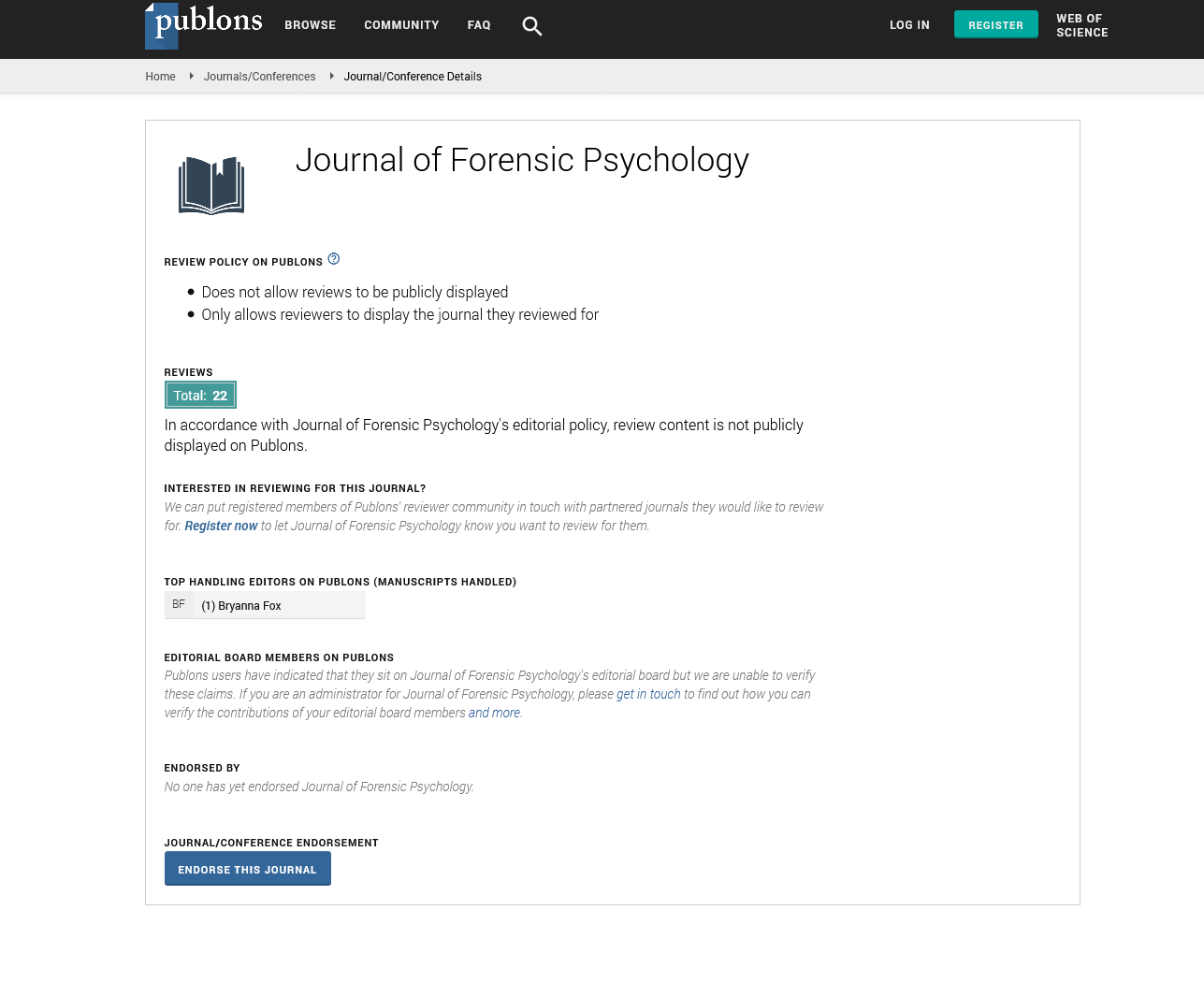Indexed In
- RefSeek
- Hamdard University
- EBSCO A-Z
- Publons
- Geneva Foundation for Medical Education and Research
- Euro Pub
- Google Scholar
Useful Links
Share This Page
Journal Flyer

Open Access Journals
- Agri and Aquaculture
- Biochemistry
- Bioinformatics & Systems Biology
- Business & Management
- Chemistry
- Clinical Sciences
- Engineering
- Food & Nutrition
- General Science
- Genetics & Molecular Biology
- Immunology & Microbiology
- Medical Sciences
- Neuroscience & Psychology
- Nursing & Health Care
- Pharmaceutical Sciences
Commentary - (2022) Volume 7, Issue 11
Psychiatric Disorder Interventions in Adolescent
Jorg Fegert*Received: 01-Nov-2022, Manuscript No. JFPY-22-19084; Editor assigned: 03-Nov-2022, Pre QC No. JFPY-22-19084 (PQ); Reviewed: 17-Nov-2022, QC No. JFPY-22-19084; Revised: 24-Nov-2022, Manuscript No. JFPY-22-19084 (R); Published: 01-Dec-2022, DOI: DOI:10.35248/2475-319X.22.7.253
Description
The frequency of psychiatric disorder among juvenile offenders has drawn more attention in recent years. This occurred in the United States as a result of research showing the inadequate mental health care provided in juvenile detention centres and a growing awareness of the unmet mental health needs of young people in general. According to Feldstein and Ginsburg, teenagers who are involved in the juvenile justice system frequently deal with a variety of interrelated issues, such as mental health diagnosis. There is evidence to support the effectiveness of motivational interviewing intervention, which is claimed to be an adequate developmental match for teenagers, in addressing such problems, including substance misuse [1-4]. Research has also shown gender inequalities in teenagers who use the juvenile justice system for psychiatric problems. Females are less likely than males to suffer psychiatric problems or engage in criminal activity, yet the minority of females who work in the justice system are at an elevated risk for internalizing disorders, according to Wasserman et aldescription's of the "gender paradox." Girls who commit crimes are far more likely to suffer from affective and anxiety disorders and this increase are particularly noticeable when the crime is violent. Although there is little empirical study, the research findings indicated that young offenders have significant rates of psychiatric disorder.
Similar results were discovered in the UK. According to prevalence estimates drawn from small research, 46% to 81% of young offenders may have mental health issues. The Mental Health Foundation's assessment found that current mental health treatments were insufficient to fulfil the needs of this demographic and urged the government to expand psychiatric care offered through the National Health programme.
Significant rates of psychiatric morbidity were discovered in Chicago adolescent detainees as part of Teplin's prevalence research. 60% of males and 67% of females still satisfied the diagnostic standards for one or more psychiatric disorders even after being ruled out for the diagnosis of conduct disorder. The rates of psychiatric problem in juvenile offenders are far higher than previously predicted, taking the research's limitations into account, and they surpass the capacity of community and institutional mental health care.
Risk factors for adolescent violence
There has been a boom in research on issues with kid behaviour during the past 15. Numerous factors have been investigated in longitudinal and cross-sectional research conducted in various nations and cultures to ascertain their relationships with subsequent crime and violence. The multifaceted nature of significant offending behaviour and violence is confirmed by a convergence of findings from several studies. As a result, a plethora of information has been gathered that may be used to create prevention and treatment strategies for kids and teenagers at various developmental stages [5].
Adolescents in England who self-report violent behaviour and criminal activity show a high frequency of actions that, if observed, would give rise to criminal charges. Approximately 30% of adolescents in the United States who participated in the "Monitoring the Future" experiment reported engaging in at least one violent act in the year prior, showing that self-reported violent conduct has remained steady over the last 25 years [6]. One would think of this as nearly the norm in adolescence given the high prevalence of antisocial and violent behaviour. However, by late adolescence, the majority of adolescents stop engaging in violent or antisocial behaviour, and very few of them go on to develop into recurrent criminals as adults.
References
- Bostock S, Crosswell AD, Prather AA, Steptoe A. Mindfulness on-the-go: Effects of a mindfulness meditation app on work stress and well-being. Journal of occupational health psychology. 2019; 24(1):127.
- European Agency for Safety and Health at Work (2009 a). OSH in figures: Stress at work facts and figures. Luxembourg: Office for Official Publications of the European Communities.
- Melchior M, Caspi A, Milne BJ, Danese A, Poulton R, Moffitt TE. Work stress precipitates depression and anxiety in young, working women and men. Psychol Med. 2007; 37(8):1119-1129.
- Stansfeld SA, Clark C, Caldwell T, Rodgers B, Power C. Psychosocial work characteristics and anxiety and depressive disorders in midlife: the effects of prior psychological distress. Occup Environ Med. 2008;65(9):634-642.
- Wang JL, Lesage A, Schmitz N, Drapeau A. The relationship between work stress and mental disorders in men and women: Findings from a population-based study. J of Epidemiol Community Health. 2008;62(1):42-47.
- Lehman BJ, Taylor SE, Kiefe CI, Seeman TE. Relationship of early life stress and psychological functioning to blood pressure in the CARDIA study. Health Psychol. 2009;28(3):338.
Citation: Fegert J (2022) Psychiatric Disorder Interventions in Violent Adolescent. J Foren Psy. 7:253.
Copyright: © 2022 Fegert J. This is an open-access article distributed under the terms of the Creative Commons Attribution License, which permits unrestricted use, distribution, and reproduction in any medium, provided the original author and source are credited.

